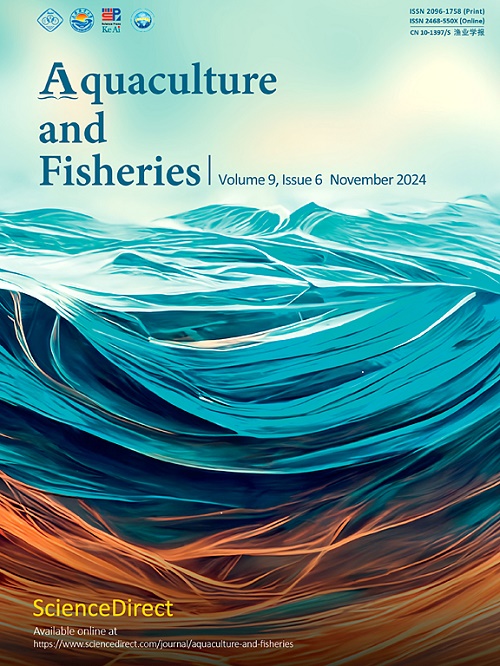Characterization of a new strain (SR-11) with thin blades and fast growth in Pyropia haitanensis (Bangiales, Rhodophyta)
Q1 Agricultural and Biological Sciences
引用次数: 0
Abstract
A new strain (SR-11) was selected from an intraspecific hybridization of a new cultivar (SF-2, ♀) and an improved strain (HR-6, ♂) of Pyropia haitanensis, and the characteristics of blades thickness, growth rate, phycobiliprotein content, and differentiation rate of conchocelis of SR-11 were analyzed through laboratory culture. After being cultured for 45 days, the mean thickness of SR-11 was 22.9 μm, which was 37.1% and 18.5% thinner than that of SF-2 and HR-6, respectively; the phycobiliprotein of SR-11 was 94.6 mg/g, increased by 4.1% and decreased by 8.4% compared with that of SF-2 and HR-6, respectively. After being cultured for 55 days, the mean length of the SR-11 was 293.7 cm, which was 3.1 and 7.2 times longer than that of SF-2 and HR-6, respectively. After the conchocelis inoculated shell were raised the temperature and shrunk of light time, the time for the emergence of a lot of conchosporangial branches in SR-11 was shorter than that of SF-2. The total number of conchospores released from per shell in SR-11 was 144.5 × 104, which was 78.1% and 11.9% higher than that of SF-2 and HR-6, respectively. In summary, the SR-11 has thinner blades, and its fresh blades may be further processed into higher value-added products. Besides, it has the advantages of fast growth, high quality and large number of conchospores released, which is expected to be applied in production cultivation.
具有薄叶片和快速生长特性的 Pyropia haitanensis(红藻纲,Bangiales, Rhodophyta)新菌株(SR-11)的特征描述
对海檀焦斑(Pyropia haitanensis)新品种(SF-2,♀)和改良菌株(HR-6,♂)进行种内杂交,筛选出一株新菌株SR-11,并通过室内培养分析了SR-11的叶片厚度、生长速率、藻胆蛋白含量和螺珠分化率等特征。培养45 d后,SR-11的平均厚度为22.9 μm,分别比SF-2和HR-6薄37.1%和18.5%;SR-11的藻胆蛋白为94.6 mg/g,比SF-2和HR-6分别提高了4.1%和8.4%。培养55 d后,SR-11的平均长度为293.7 cm,分别是SF-2和HR-6的3.1倍和7.2倍。在提高接种螺壳的温度和缩短光照时间后,SR-11的螺孢子囊分支出现的时间比SF-2短。SR-11单壳释放螺孢子总数为144.5 × 104个,分别比SF-2和HR-6高78.1%和11.9%。综上所述,SR-11的叶片更薄,其新鲜叶片可以进一步加工成更高附加值的产品。此外,它还具有生长快、质量好、释放螺孢子量大等优点,有望在生产栽培中得到应用。
本文章由计算机程序翻译,如有差异,请以英文原文为准。
求助全文
约1分钟内获得全文
求助全文
来源期刊

Aquaculture and Fisheries
Agricultural and Biological Sciences-Aquatic Science
CiteScore
7.50
自引率
0.00%
发文量
54
审稿时长
48 days
期刊介绍:
 求助内容:
求助内容: 应助结果提醒方式:
应助结果提醒方式:


